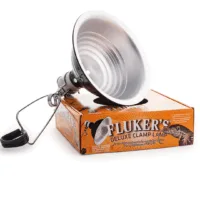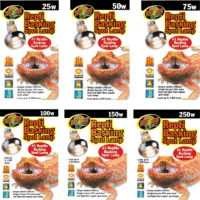Description
Zoo Med ReptiSun 10.0 Compact Fluorescent UVB Bulb (10% UVB)
ReptiSun 10.0 Mini is Perfect for all desert and basking reptiles Such as Bearded Dragons, Uromastyx, Iguanas, Turtles, Tortoises and other reptiles that require high levels of UVB! Please research the UVB needs of your specific pet.
The output of these UVB bulbs is 10% UVB and 30% UVA Output, plus full spectrum visible light. (these bulbs are not a heat source for reptiles)
The ReptiSun Compact Fluorescent lamps use a special UVB transmitting quartz glass for maximum UVB penetration. Cool burning compact fluorescent bulbs screw into standard threaded sockets, eliminating the need for a separate ballast. Lamp can be oriented either vertically or horizontally in your reptile hood or clamp lamp fixture. UVB emissions help prevent or reverse Metabolic Bone Disease and UVA increases feeding, mating, and other natural behaviors. Perfect for Mini Deep Dome Lamp Fixtures and Naturalistic Terrarium Hoods.
- When choosing the best UVB bulb for your reptile pets, please consider how strong (%) they require, for how long a day they require to bask in UVB and the distance they require the UVB bulb to be away from their body (Also called the Ferguson zone)
- This bulb will provide your reptiles with beneficial UVB light up to 9″ (23cm) from the lamp to the basking spot.
- Combine the correct UVB bulb and the appropriate heat source to your reptiles basking needs. Check out all our available options in our Lighting and Heating Section.
- This bulb will fit in most light fixtures and domes
- Compact Fluorescent UVB Bulbs should be replaced every12 months when used for 10-12 hours a day, regardless of the visible light still operational. This is because the effectiveness of the UVB spectrum diminishes over time.
- May be placed above a screen or directly into the enclosure (use a wire protector to prevent the animal from touching the bulb.) Please note that UVB DOES NOT penetrate through glass.
Pro Tip
Write the date you install the bulb into the fixture on the metal cap, using a permanent marker. Then set a reminder on your cell phone to order a replacement bulb.
ReptiSun 10.0 Compact Fluorescent UVB Bulb (10% UVB) are available for sale and shipping in Canada
To learn more about Reptiles and why UVB is so vitally important to them, please see below
Reptiles and UVB Light
UVB:
UVB is a necessary part of the process in which vitamin D3 is produced in the skin of humans and animals, and is also what causes sunburn in humans. The vitamin D3 that is produced is responsible for regulating calcium metabolism. Vitamin D3 is obtained through diet or UVB exposure.
Since most reptile species are unable to utilize dietary vitamin D3, they must have access to UVB. A lack of UVB and vitamin D3 can ultimately result in metabolic bone disease (MBD) in reptiles, and rickets in humans. Nearly all animals that are active during the day are exposed to some level of UVB. In the early days of keeping reptiles, little was known about the specialized lighting requirements of the majority of reptile species. During this time, reptiles housed indoors were not exposed to UVB, and as a result would often develop Metabolic Bone Disease (MBD).
MBD causes reptiles’ bones to become soft resulting in severe deformities of the spine, broken legs, and soft jaws. In severe cases, the internal organs would calcify and become hard which ultimately resulted in death. The majority of the cases of MBD occurred in Green Iguanas due to their popularity as pets, and to the fact that UVB exposure was necessary in order for them to remain healthy. Zoo Med understood that Iguanas kept outdoors did not develop MBD, while Iguanas fed the same diet but housed indoors did. This prompted Zoo Med to experiment with UVB in fluorescent lighting, and ultimately led to the release of the ReptiSun line of UVB lamps.
Zoos, Veterinarians and hobbyists soon learned that all but the worst cases of MBD were reversible upon exposure to Zoo Med’s ReptiSun lighting. In addition, reptiles that had access to UVB from ReptiSun lamps as hatchlings never developed MBD. We now know that most diurnal (daytime active) reptiles require UVB. Since the release of the ReptiSun UVB lamps, dozens of scientific studies have confirmed their beneficial effect on reptiles. From the results of these studies, we can now make recommendations on exposure times, distances, and lamp replacement intervals. Researchers have determined the UVB levels required by some reptile species in captivity.
For tropical reptile species, including chameleons and Iguanas, UVB levels of 13 to 30 W/cm2 (microwatts per square centimeter) are recommended when lamps are used 10 to 12 hours per day. Desert species (e.g. Bearded Dragons) can tolerate slightly higher levels from 13 to 150 W/cm2.
For all reptile species, it is important to provide a UVB gradient that allows the reptile to adjust its UVB exposure. This can be achieved with elevated branches and other climbing decor at various distance from the light source in a terrarium.
All reptiles should have access to a minimum of 13 microwatts of UVB in order to synthesize vitamin D3, metabolize calcium, and maintain healthy bone density. Lamps that emit less than 13 microwatts at the reptiles basking site should not be used as they are likely incapable of providing sufficient UVB. Reptiles that do not get enough UVB are in danger of developing Metabolic Bone Disease (MDB). Reptiles also require heat in order to benefit from UVB and synthesize vitamin D3.
Levels above 150 microwatts are seen in nature, but can be dangerous in a captive setting. Screen covers on terrariums filter out a portion of the UVB from all lamps, while glass and most plastics filter out 100% of the UVB.
UVA:
It is well established in the scientific literature that reptiles and amphibians can actually see UVA. This has also been documented in birds and fish.
Humans have three different types of cones in our retina, each one being sensitive to different wavelengths. From these three types, we are able to make up our entire color spectrum. Humans that are red/green colorblind lack the third cone type and only have two.
Birds, reptiles and amphibians possess FOUR different cone types instead of three. The fourth cone is sensitive to emissions in the UVA portion of the electromagnetic spectrum. This fourth “primary color” makes up the birds entire range of visible light. By not providing UVA, reptiles are essentially colorblind. It is similar to the condition of colorblindness in humans. Knowing this, it could be considered negligent to deny pet reptiles access to UVA as this is essential to their psychological well being.
Studies have shown that glands on the hind legs of some lizards secrete a substance that reflects UVA and is used by them to mark territories. UVA plays a role in habitat selection, species recognition, and in mate selection among reptiles and amphibians.
What is the Ferguson Zone?
The Ferguson Zones were developed in 2010 by Professor Gary Ferguson of the Texas Christian University. Ferguson and his team of herpetologists gathered data of the daily UV exposure of 15 species of reptiles. In the publication that followed, these 15 species were divided into four groups according to their thermoregulatory behaviour (daily sun exposure) and microhabitat preferences: the “Ferguson Zones”. The corresponding UV guidelines were based on the average irradiance of randomly encountered wild specimens: Zone 1 with the least, to Zone 4 with the highest exposure.
The British and Irish Association of Zoos and Aquaria (BIAZA) built on Dr Ferguson’s research to allocate Ferguson Zones to hundreds of species of reptiles and amphibians. With the help of 14 zoological organisations, specialist reptile keepers and private herpetologists, a total of 254 species were grouped into the 4 Ferguson zones.
A summary of the 4 zones, their corresponding UVI gradient and for each zone a few examples of commonly kept species:
Zone 1 = Crepuscular or shade dweller, thermal conformer
- Average exposure: UVI 0-0.7; maximum recorded: UVI 0.6-1.4
- Animals that avoid direct sunlight e.g. Crested Gecko, Leopard Gecko, Burmese Python, Milk Snake
Zone 2 = Partial sun/occasional basker, thermoregulator
- Average exposure: UVI 0.7-1.0; maximum recorded: UVI 1.1-3.0
- Occasional basking for short periods of time (Green Anole, Boa Constrictor, Ornate Box Turtle, Australian Water Dragon)
Zone 3 = Open or partial sun basker, thermoregulator
- Average exposure: UVI 1.0-2.6; maximum recorded: UVI 2.9-7.4
- Basking in full sunlight in the morning or early afternoon, or during mid-day when it’s partially clouded (Frilled Lizard, Yemen Chameleon, Standing’s Day Gecko, Leopard Tortoise)
Zone 4 = Mid-day sun basker, thermoregulator
- Average exposure: UVI 2.6-3.5; maximum recorded: UVI 4.5-9.5
- Basking in full sunlight, possibly at any time of the day (Chuckwalla, Uromastyx, Rhinoceros Iguana, Marginated Tortoise)



















